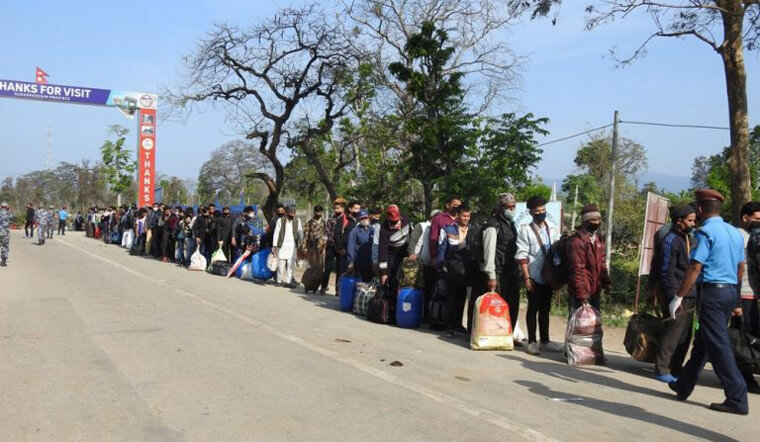Disclaimer:
Please be aware that the content herein has not been peer reviewed. It consists of personal reflections, insights, and learnings of the contributor(s). It may not be exhaustive, nor does it aim to be authoritative knowledge.
Title
Please provide a name for your action learning plan.
Addressing the issue of COVID-19 induced youth unemployment and job displacement of returnee migrants and beyond.
Challenge statement
Challenge type: If you are working on multiple challenges, please indicate if this is your "big bet" or "exploratory" challenge.
Please note: we ask you to only submit a maximum of 3 challenges - 1x Big Bet, 2x Exploratory. Each challenge must be submitted individually.
BIG BET
Challenge statement: What is your challenge? (Please answer in specific terms: "Our challenge is that...”.)
Our challenge is that during the pandemic more than 500,000 Nepali men and women migrants entered to Nepal from abroad and those already in rural parts of the country have reported a significant drop in the income due to mass unemployment.
Background: What is the history of your challenge? What is causing or driving it? Who is involved? How does the current situation look like? What undesired effects does it produce?
As per the Migration Report (2020)- The Department of Foreign Employment (DOFE) has issued over 4 million labour approvals o Nepali workers since 2008/2009. Labour migration is one of the prominent reasons for an exodus of Nepalis going abroad for better opportunities. However, the recent pandemic has reversed this scenario and in a matter of few months hundreds and thousands of Nepalis returned home indefinitely. Majority of them without a financial cushion during the onset of a pandemic, to make matters more challenging the nation wide lockdown which was enforced in Nepal on 24th March 2020 resulted in 3 out of 5 people to loose their job. Thus, the government had a very challenging task of managing the in-flow of migrants, providing them livelihood opportunities and at the same time provide means of livelihood to thousands of Nepalis who were out of jobs. To make matters worse, the local level government who are responsible for facilitating employment opportunities at the local levels did not have a database or a system in place to track the overall demand and supply of workers in the market. Due to the lack of data and a system in place, job seekers couldn't look for opportunities in the market and job providers couldn't find the available human resource at their disposal. As a result, Nepal's projected pre-COVID GDP growth rate of 8.5% will decline to well below 2.5% in [REDACTED_PHONE] and severely constrain a rebound in [REDACTED_PHONE] (UNDP Nepal, 2020). Apart from the financial strain, due to desperation, loneliness and feeling of helplessness the suicide rates during the pandemic has gone up by 25% since same time last year in Nepal (Nepali Times, 2020).
Quantitative evidence: What (official) data sources do you have on this challenge that better exemplifies the importance and urgency of this frontier challenge? You can add text, a link, or a picture.
https://www.ilo.org/wcmsp5/groups/public/---asia/---ro-bangkok/---ilo-kathmandu/documents/briefingnote/wcms_748917.pdf https://data.worldbank.org/indicator/SL.UEM.1524.ZS?locations=NP
https://www.ceslam.org/uploads/backup/research-paper-x-covid-19.pdf
Qualitative evidence: What weak signals have you recently spotted that characterizes its urgency? Please provide qualitative information that better exemplifies the importance and urgency of this frontier challenge. You can add text, a link, or a picture.
https://www.aljazeera.com/news/2020/4/1/hundreds-of-nepalese-stuck-at-india-border-amid-covid-19-lockdown
Value proposition: What added value or unique value proposition is your Accelerator Lab bringing to solving this challenge? Why is it your Lab that needs to work on this challenge and not other actors within UNDP, other stakeholders in the country respectively? Why is it worth investing resources to this challenge?
Accelerator Lab Nepal has mapped stakeholders and key eco-system players in regards to find solutions to the issue of rising unemployment in Nepal and based on our series of discussions and outcomes from our learning tools, we were able to design, develop and deploy an Artificial Intelligence enabled digital system called "SipShala" (Skills Lab), that maps the skill sets of 100,000 (estimated) returnee migrants in average and matches them with the opportunity providers through job matching algorithms. This system will also help in maintaining a rich pool of migrant database that could be useful for the local level government to plan localised employment campaigns.
Short “tweet” summary: We would like to tweet what you are working on, can you summarize your challenge in a maximum of 280 characters?
#SipShala is a digital solution that maps the skill sets of returnee migrants & out-of-job-population & matches them with opportunity providers through job matching algorithm. We see this as a potential solution to address the issue of youth unemployment during a pandemic.
Partners
Who are your top 5 partners for this challenge? Please submit from MOST to LEAST important and state Name, Sector and a brief description of the (intended) collaboration.
Please state the name of the Parter:
Local Level Government
What sector does our partner belong to?
Government (&related)
Please provide a brief description of the collaboration.
UNDP is closing working with local level government as they are responsible for local economic development post COVID-19 and also to lead initiatives for massive job re-integration for those who have lost all source of livelihood due to the pandemic.
Is this a new and unusual partner for UNDP?
No
Who are your top 5 partners for this challenge? Please submit from MOST to LEAST important and state Name, Sector and a brief description of the (intended) collaboration.
Please state the name of the Parter:
CellApp Innovations
What sector does our partner belong to?
Private Sector
Please provide a brief description of the collaboration.
Cell App innovations are the technology providers for this digital system. They are responsible for creating the UI/UX of the system.
Is this a new and unusual partner for UNDP?
Yes
Who are your top 5 partners for this challenge? Please submit from MOST to LEAST important and state Name, Sector and a brief description of the (intended) collaboration.
Please state the name of the Parter:
Returnee Migrants Association of Nepal
Learning questions
Learning question: What is your learning question for this challenge? What do you need to know or understand to work on your challenge statement?
How do we encourage more and more job seekers and providers to use this digital system to gain a clear understanding of the demand and supply side of the job market?
To what stage(s) in the learning cycle does your learning question relate?
Test
Usage of methods: Relating to your choice above, how will you use your methods & tools for this learning question? What value do these add in answering your learning question?
1. Artificial Intelligence/ Machine Learning: The portal has integrated a tool called "AI Magic" whose algorithm helps the skills and interest of job seekers with job providers. 2. Behavioral Insights: We will be using BI to understand the user experience of being on the portal from the perspective of both job seekers and job providers. The information gained from this exercise will help fine-tune the portal for maximum user-friendliness. 3. Collective Intelligence: Collective Intelligence can helps us better understand the nuances within the system and the environment that would further motivate and encourage more and more job seekers to register themselves in the platform and also understand if there are pre-existing challenges within the system and the environment that is discouraging users to enter data. 4. Data Visualisation: This can help us make sense of dis-aggregated data in terms of successful male and female job matches, geographical concentration of job opportunities etc. 5. Pilots: The SipShala portal has already completed its Beta Version phase, during the pilot, we tested the overall scope with local level government and by the end of the experiment we hope to tentatively match some 100,000 jobs through the portal.
Existing data gaps: Relating to your choice above, what existing gaps in data or information do these new sources of data addressing? What value do these add in answering your learning question?
1. Social media: The social media analytics will help in understanding the outreach level vs take-up level of this digital portal, and see if there is a big gap between the two. This information will support our learning question by helping us understand the adoption/ engagement level towards the proposed solution by our target audience. The social media analytics will also provide dis-aggregated data in terms of gender, age, location etc. 2. User journeys: User journeys will helps us gain insights on the user's experiences when interacting with softwares, which was not possible to know before. 3. Direct interviews: Direct interviews will help us break the ice when it comes to gaining the first hand user experience of a service which would be a different exercise than the one's we do collectively. 4. Tracking data: Tracking data will help us to find more job seekers and providers in the market and help expand the overall horizon of this experiment.
Closing
Early leads to grow: Think about the possible grow phase for this challenge - who might benefit from your work on this challenge or who might be the champions in your country that you should inform or collaborate with early on to help you grow this challenge?
The main party to benefit from the grow phase of this challenge is the job seekers themselves. But also the local level government who can claim to be successful in mitigating the risk of unemployment caused by the pandemic. The potential collaboration to help grow this challenge can be connecting it with the Prime Minister's Employment Programme, whereby the scope of the project can exponentially grow and at the same time various multi-level formal and informal sector jobs can be opened up for normal people which was not accessible before, this will in-turn help digitise and develop the nascent gig economy in Nepal.
END OF ACTION LEARNING PLAN: Thank you! The form saves automatically and your submission has been recorded. You may now exit this window.


 1No poverty
1No poverty
 8Decent work and economic growth
8Decent work and economic growth 17Partnerships for the goals
17Partnerships for the goals
Comments
Log in to add a comment or reply.